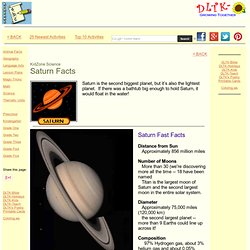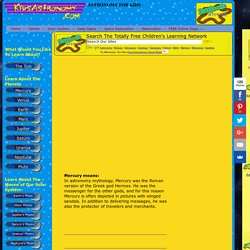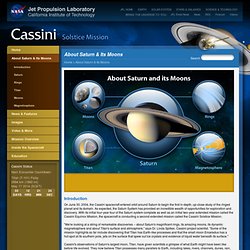

Planet Facts. Saturn is the second biggest planet, but it’s also the lightest planet.

If there was a bathtub big enough to hold Saturn, it would float in the water! Saturn Fast Facts Distance from Sun Approximately 856 million miles Number of Moons More than 30 (we're discovering more all the time -- 18 have been named Titan is the largest moon of Saturn and the second largest moon in the entire solar system. Diameter Approximately 75,000 miles (120,000 km) the second largest planet -- more than 9 Earths could line up across it! Composition 97% Hydrogen gas, about 3% helium gas and about 0.05% methane, plus ammonia. Length of Day 10 hours, 39 minutes in Earth time (the length of one rotation) flattened at the poles because of its very rapid rotation Length of a Year 29.5 Earth years (the length of one orbit around the sun) Name named for the Roman god of agriculture.
Visited by Pioneer 11, Voyager 1, Voyager 2, Cassini (2004) Saturn's Rings Saturn's rings can be seen with even a small telescope. Mercury. Mercury means: In astronomy mythology, Mercury was the Roman version of the Greek god Hermes.

He was the messenger for the other gods, and for this reason Mercury is often depicted in pictures with winged sandals. In addition to delivering messages, he was also the protector of travelers and merchants. How much would you weigh on Mercury? If you moved to Mercury you would not weigh as much as you do on Earth. Not because you would lose weight on the spaceship, but because Mercury is smaller, and so has less gravity.
The Planet The planet Mercury is the closest of the planets to the Sun. This planet is often called a morning star. Mercury is Heavy Because of its proximity to the Sun, Mercury's evolution took a slightly different course than that of the other planets. Scope.swf (Objet application/x-shockwave-flash) About Saturn & Its Moons. Introduction On June 30, 2004, the Cassini spacecraft entered orbit around Saturn to begin the first in-depth, up-close study of the ringed planet and its domain.

As expected, the Saturn System has provided an incredible wealth of opportunities for exploration and discovery. With its initial four-year tour of the Saturn system complete as well as an initial two-year extended mission called the Cassini Equinox Mission, the spacecraft is conducting a second extended mission called the Cassini Solstice Mission.
"We're looking at a string of remarkable discoveries -- about Saturn's magnificent rings, its amazing moons, its dynamic magnetosphere and about Titan's surface and atmosphere," says Dr. Linda Spilker, Cassini project scientist. Cassini's observations of Saturn's largest moon, Titan, have given scientists a glimpse of what Earth might have been like before life evolved. Why the "Cassini Solstice Mission? " Science Objectives.